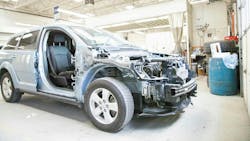At the time of this writing, I am hearing of some metro-area shops having near-Covid levels of customer demand, with some technicians even going home early. There is one KPI (key performance indicator) we used to hear about a lot but since the gold rush of high collision repair demand the last three years has gone silent. That KPI is cycle time, and most independent shops couldn’t care less whether a repaired car leaves within five days or 35 days of arrival. But if you want customers to leave as raving fans, you had better start caring!
Let’s look at just one company and what effect their “cycle time” has had on our society and the growth and profits for their business. Jeff Bezos is one of the top three richest men on the planet, with a net worth of over $200,000,000,000 ($200 billion). For those who aren’t aware, Mr. Bezos created Amazon. Over 80% of the US population uses Amazon, including myself.
What makes Amazon so special? Well, several things do.
- Fast delivery
- We get what we ordered.
- Returns are not a huge hassle.
- A fair price.
Let’s say everything went well when ordering an Amazon product, but instead of an average of a 4–5-day delivery time, it took 21-days. Would Amazon still be used by 80% of the Americans? Well, that depends on the delivery times of the same products from Amazon’s competitors. If other online retailers could have the same products to us in, say, 10 days on average, at a similar price and correctness of order rather than the 21-day scenario, Amazon would have literally no competitive advantage.
Changing Our Mindset
Let’s look at this from the perspective of a vehicle owner who has just backed into a pole. For them, their “cycle time” of getting their car fixed started as soon as they hit the pole. Unfortunately, most shops look at cycle time starting when we get the customers keys to their vehicle. With customer demand currently dropping and very likely a new norm, we will need to change our mindset from the past three years of work abundance.
In the world of lean manufacturing, there are seven types of waste. Without diving in deep here, one of the seven biggest wastes is inventory. Some shop owners will revel when looking at their parking lot when it's stacked full of customers vehicles. Well, the only way that can be a good thing for our business is if they are all total losses collecting storage. If most of the vehicles are to be repaired, then it’s a very bad thing! Look at this way: let’s say your shop produces three cars per day, or 15 cars per week. If you have 45 cars onsite, that means the next car dropped off will have a 21-day cycle time, or three weeks until the car leaves repaired. If you have 60 cars onsite, that’s a four-week inventory of cars, or a four-week cycle time.
With a high inventory of cars onsite, we often are blinded to just how much chaos and work this creates. Every one of those customers wants to be updated whether their car is being worked on or not. There always seems to be a car in front of the one you need to get out, keys need to be located, multiple parts carts are everywhere, cash is tied up in labor of blueprinted vehicles and any parts that have been invoiced. Cash flow is tight, and everyone is just stressed out, especially the owner of the business.
Ways to Lower Cycle Times
Many reading this will say they have to wait sometimes weeks on end for the insurer to give approvals. For my shop, rarely do we wait for approval to move forward after a blueprint. "Isn't that risky?” you ask. Well, let’s say an insurer calls and gets upset that we have moved forward on a $50,000 vehicle with a $6,000 repair cost. How should we respond? Here is what I was taught. “Mr. Insurer, I have a signed authorization to repair the vehicle from the owner, and I am not sure who you are.” Granted, we keep all old parts until approval etc., but keeping the customer as our No.1 priority should be our goal.
There are many more ways outside of getting approvals to lowering cycle times, like proper scheduling of inputs and outputs, possibly preordering parts, 100% blueprint, mapping the vehicle, thorough mirror-matching process, confirming techs have reviewed the estimate, proper QC, deductibles confirmed at drop-off, etc.
My responsibility as the owner of my shop is to keep enough work coming in the door. At the end of the day, we each must figure out what our competitive advantage is to a customer using our shop over another.
